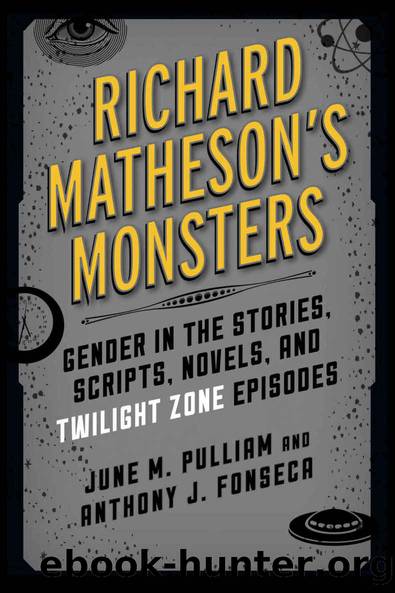Richard Matheson's Monsters: Gender in the Stories, Scripts, Novels, and Twilight Zone Episodes (Studies in Supernatural Literature) by June M. Pulliam & Anthony J. Fonseca

Author:June M. Pulliam & Anthony J. Fonseca [Pulliam, June M.]
Language: eng
Format: epub
Tags: undefined
Publisher: Rowman & Littlefield Publishers
Published: 2016-02-14T23:00:00+00:00
Will Smith as Neville avoids being viewed the way the national media attempted to cast New Orleans’ African American community after Katrina, as selfish black people looking for high-priced appliances. In this film, looting is “reframed as a tactic of survival rather than unbridled avarice,” and night scenes, wherein albino dark-seekers wander the streets looking for prey, create a “counternarrative of ‘blackness.’”[19] While Robert Neville’s town house is stocked with fine art and electronics, we witness only his attempts to find food and supplies—he even courteously, like a good, productive postapocalyptic citizen, returns DVDs to a rental shop (occupied by white mannequins).
While I Am Legend presents a more progressive narrative about race, it reproduces sexist ideas about gender by representing women as dangerous and Other. The pandemic is caused by, and ultimately named after, Dr. Alice Krippin, a white female scientist who invents a cure for cancer by genetically reengineering the measles virus. Krippin disappears from the film after the opening scene, her displacement reinforcing gender boundaries (of science) and enhancing masculinity, for her virus kills 90 percent of the world’s population. Nine percent become infected dark-seekers, who have devolved into a primal state of aggression, hunting down and killing most of the remaining 1 percent uninfected population.
Smith is a military scientist, a convenient way to allow the film’s writers and directors to embody conventional masculinity: he is athletic; he has expertise with firearms; he has a working knowledge of science; he is an expert driver and auto mechanic. Women are helpmates, like fellow survivor Anna or his now dead wife. When women step out of this role or, worse still, attempt to do what is considered men’s work, they are dangerous—as is the case with Krippin. Like Heston, Smith is positioned as a Christ figure, a man whose willingness to sacrifice himself for others is the highest expression of his masculinity. The film’s conflation of Robert Neville with Bob Marley reinforces this: Marley’s music, specifically the 1984 song “Three Little Birds,” and Marley’s overall message figure prominently in Neville’s life. He plays “Three Little Birds” and sings along to it, associating him with Marley, “a sole revolutionary who survives against the odds.”[20] Neville’s now deceased daughter was even named Marley, as he so admired the singer for what he in the film describes as Marley’s “virologist idea,” that it was possible to cure racism and hate by injecting love into people’s lives.
Unlike Heston’s, Smith’s portrayal is compassionate and forgiving. His Robert Neville possesses enough self-control not to resort to violence. Here Neville becomes the polar opposite of Matheson’s protagonist: he is not the monster obsessed with blood purity, but an aspiring humanitarian who battles the dark-seekers, the film’s metaphoric representation of racists. Moreover, he believes they are capable of reform, so he pleads with them when they surround him, telling them that they are sick, that he can help them. Smith’s portrayal pays homage to Price more than to Heston—he too is a Christ figure, except he sacrifices himself
Download
This site does not store any files on its server. We only index and link to content provided by other sites. Please contact the content providers to delete copyright contents if any and email us, we'll remove relevant links or contents immediately.
Call Me by Your Name by André Aciman(20370)
Ready Player One by Cline Ernest(14518)
How to Be a Bawse: A Guide to Conquering Life by Lilly Singh(7382)
Wiseguy by Nicholas Pileggi(5666)
The Kite Runner by Khaled Hosseini(5079)
On Writing A Memoir of the Craft by Stephen King(4862)
Audition by Ryu Murakami(4840)
The Crown by Robert Lacey(4722)
Call me by your name by Andre Aciman(4610)
Gerald's Game by Stephen King(4570)
Harry Potter and the Cursed Child: The Journey by Harry Potter Theatrical Productions(4438)
Dialogue by Robert McKee(4320)
The Perils of Being Moderately Famous by Soha Ali Khan(4169)
Dynamic Alignment Through Imagery by Eric Franklin(4115)
Apollo 8 by Jeffrey Kluger(3634)
The Inner Game of Tennis by W. Timothy Gallwey(3575)
Seriously... I'm Kidding by Ellen DeGeneres(3574)
How to be Champion: My Autobiography by Sarah Millican(3554)
Darker by E L James(3474)
